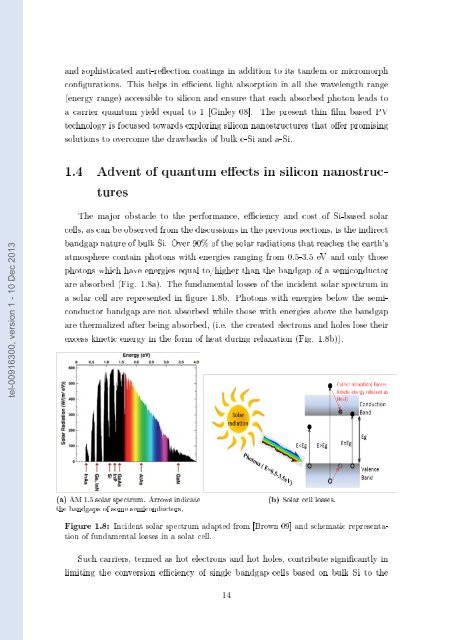Films minces à base de Si nanostructuré pour des cellules ...
Films minces à base de Si nanostructuré pour des cellules ...
Films minces à base de Si nanostructuré pour des cellules ...
You also want an ePaper? Increase the reach of your titles
YUMPU automatically turns print PDFs into web optimized ePapers that Google loves.
and sophisticated anti-reection coatings in addition to its tan<strong>de</strong>m or micromorph<br />
congurations. This helps in ecient light absorption in all the wavelength range<br />
(energy range) accessible to silicon and ensure that each absorbed photon leads to<br />
a carrier quantum yield equal to 1 [Ginley 08]. The present thin lm <strong>base</strong>d PV<br />
technology is focussed towards exploring silicon nanostructures that oer promising<br />
solutions to overcome the drawbacks of bulk c-<strong>Si</strong> and a-<strong>Si</strong>.<br />
1.4 Advent of quantum eects in silicon nanostructures<br />
tel-00916300, version 1 - 10 Dec 2013<br />
The major obstacle to the performance, eciency and cost of <strong>Si</strong>-<strong>base</strong>d solar<br />
cells, as can be observed from the discussions in the previous sections, is the indirect<br />
bandgap nature of bulk <strong>Si</strong>. Over 90% of the solar radiations that reaches the earth's<br />
atmosphere contain photons with energies ranging from 0.5-3.5 eV and only those<br />
photons which have energies equal to/higher than the bandgap of a semiconductor<br />
are absorbed (Fig. 1.8a). The fundamental losses of the inci<strong>de</strong>nt solar spectrum in<br />
a solar cell are represented in gure 1.8b. Photons with energies below the semiconductor<br />
bandgap are not absorbed while those with energies above the bandgap<br />
are thermalized after being absorbed, (i.e. the created electrons and holes lose their<br />
excess kinetic energy in the form of heat during relaxation (Fig. 1.8b)).<br />
(a) AM 1.5 solar spectrum. Arrows indicate<br />
the bandgaps of some semiconductors.<br />
(b) Solar cell losses.<br />
Figure 1.8: Inci<strong>de</strong>nt solar spectrum adapted from [Brown 09] and schematic representation<br />
of fundamental losses in a solar cell.<br />
Such carriers, termed as hot electrons and hot holes, contribute signicantly in<br />
limiting the conversion eciency of single bandgap cells <strong>base</strong>d on bulk <strong>Si</strong> to the<br />
14
















